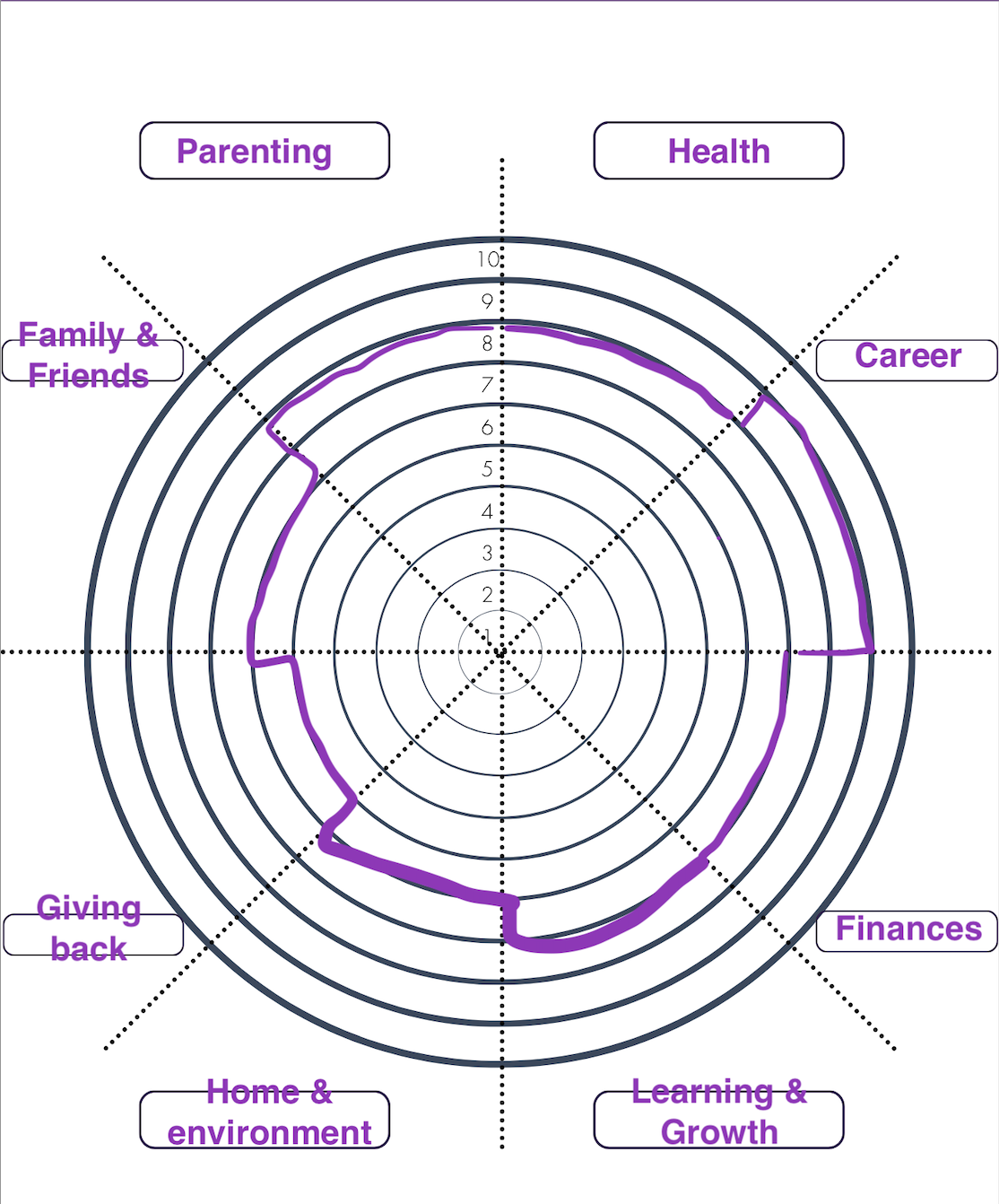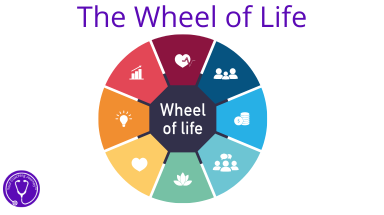Prefer to listen?
This blog post forms the basis of a podcast on our new coaching model, which you can listen to here.
The Wheel of Life is a popular tool helps clients take a view of and assess different areas of their lives, but did you know it’s much more versatile than its name suggests? In fact, it could be a “Wheel of Anything,” depending on what your client wants to explore. This adaptability makes it an invaluable resource for coaches at all levels.
What Is the Wheel of Life?
The traditional Wheel of Life is a simple yet powerful tool. It starts as a circle, often divided into segments (usually eight), each representing a different area of life. The idea is that the client rates each area on a scale of 1 to 10, with 10 being the ideal and 1 representing dissatisfaction. Once those scores are plotted on the wheel, clients can visually see which areas of their life might need more attention. And sometimes, which might need less attention!
Here’s an example of a completed wheel of life.

The wheel of life is ideal as a starting point in coaching, especially if your client doesn’t know exactly what they want to focus on. And the beauty of the wheel is that it’s customisable. You can use it to explore anything, from work-life balance to leadership development to personal values. Let’s break down how you can get creative with it.
Using The Wheel of life In A Coaching Session
When you sit down with a client, if they’re unsure where to begin, just grab a pen and paper and draw a circle. It’s that simple! From there, divide the circle into as many segments as needed (usually eight). These segments are like spokes on a wheel, and each one represents an area the client wants to work on. Alternatively, you may choose to send your client a PDF document of a wheel that they can print out and complete prior to your coaching session.
Ask your client to identify the areas of their life that are important to them and to label each segment. Examples include: career, health, relationships, personal growth, community, giving back, family friends, hobbies, financial stability, fitness, spirituality.
Top Tip: The areas don’t have to be predefined, and probably shouldn’t be. Let your client decide what’s important to them in the moment.
Once the segments are labelled, ask your client to assign each a score from 1 to 10 along the spokes to represent where they currently stand in each area. They can then draw a line round joining each segment up. This helps to give a clear visual on where they are most satisfied in their life. Then, ask them where they want to be and create another shape joining up each of these – perhaps do this in a different colour. The gap between where they are now and where they want to be is what you’ll explore together during the coaching sessions.
The Power of Self-Reflection
The real magic of the Wheel of Life (or Wheel of Anything) is the self-reflection it prompts. By rating areas of their life, clients gain insight into what’s truly important to them and where they feel out of balance. Perhaps they’re excelling in their career (scoring a 9), but their health and relationships (scoring a 3 and a 4) are being neglected.
Once you’ve plotted the scores, clients often find that they can see the discrepancy instantly. If the wheel looks bumpy or uneven, that’s a visual cue that something in their life might need more attention. This can be a powerful way to begin a coaching conversation, as it gives both the client and coach a clear starting point.
Customising the Wheel: The Wheel of Anything
While the Wheel of Life is great for overall life balance, you don’t have to limit yourself to this single framework. Depending on what the client wants to work on, you can create a “Wheel of Leadership,” a “Wheel of Wellness,” or even a “Wheel of Values.”
For example, if a client is feeling disconnected from their core values, you could create a Wheel of Values. Each segment would represent a different value (like honesty, creativity, or collaboration). The client could then rate how well they feel those values are being expressed in their life. Maybe they work in a toxic environment where their value of honesty is stifled, so it might score a 2. This exercise can be especially helpful in situations where a client feels misaligned with their surroundings.
You could also use a Wheel of Leadership to help someone in a managerial role assess different leadership skills, like decision-making, team communication, and delegation. What areas do they want to develop? What do they feel most confident in?
The possibilities are endless.
How to Avoid Feeling Overwhelmed
With all this potential, it’s easy for both clients and coaches to feel overwhelmed by the number of areas they could focus on. After all, each segment of the wheel represents a different facet of life, and it’s natural to feel like there’s a lot of work to do!
Here’s a helpful tip to keep things manageable: Focus on small, incremental improvements. If a client is at a 3 in one area, they don’t need to jump to a 10 right away. Aim to help your coachee find small, actionable steps that will gradually move the score from a 3 to a 4 or a 5. These little wins build momentum and give clients a sense of progress. Over time, these small steps can lead to significant changes.
Tracking Progress with the Wheel
One of the most rewarding aspects of using the wheel is how it tracks progress. As clients make small changes, they can revisit the wheel in subsequent sessions and update their scores. Over time, they’ll see the visual representation of their progress—and so will you, as the coach.
For instance, a client may start with a score of 2 in fitness, and after a few weeks of consistent effort, they’ve moved up to a 5. This provides tangible evidence that coaching is working and helps clients see how far they’ve come. It also allows them to reassess and adjust their focus areas as needed.
A Versatile Tool for Any Coaching Conversation
The Wheel of Life is a flexible tool that can help clients clarify their goals, identify areas for growth, and track their progress in a visual and engaging way.
Ultimately, the wheel is a tool to spark conversation. It’s not about getting the “perfect” score in each area or making everything perfectly balanced. It’s about giving clients the space to explore what’s important to them and guiding them toward realistic and meaningful change.
Final Thoughts: Whether you’re a coach or someone considering coaching, the Wheel of Life (or Wheel of Anything) is an incredibly versatile and accessible tool.
Want to try it yourself?
Download a customisable wheel template here and start your own coaching journey today.
The wheel of life is a tool from the Solution Focussed Approach to coaching, one of many approaches that we cover on our diplomas. To find out more about our Doctors’ Transformational Coaching Diploma click through here



